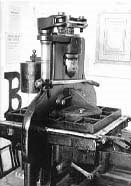Stanhope No.108
This historic printing press, dating from 1813, is the jewel in the crown of Wai-te-ata Press, on long-term loan from Cambridge University Press, UK.

The Press owes its existence in large part not only to the enthusiasm and forward thinking of its founder, but to the arrival of its first piece of equipment, a Stanhope Press, on indefinite loan from Cambridge University Press, UK.
Designed by the third Earl Stanhope as the first cast iron press in the printing profession, this particular press (number 108) dates from 1813 and is assumed to be the last press fabricated by Stanhope's engineer, Robert Walker of Vine Street, Piccadilly. The University Printer at Cambridge University paid Sarah, widow of Robert Walker, the grand sum of £88 for the press. It was used extensively throughout the next century and a half.
Wai-te-ata Press's fine specimen, restored to fully operational condition, is one of only 16 such presses left in the world. It is also the oldest printing press in New Zealand, pre-dating those imported by the French and English in the colonial period by some twenty years.
Until 1952, this particular Stanhope was still used by Cambridge University, reserved for the dignified task of overprinting the Vice-Chancellor's signature on certificates. Between 1953 and 1957, it was part of the Water Lane Press, a small bibliographical printing house in King's College, Cambridge, run by the eminent bibliographer Philip Gaskell. James Mosely, formerly Chief Librarian of the St Bride Printing Library, London recalls with fondness the hundreds, if not thousands of sheets pulled with this press. In fact, generations of students may not be aware that the photograph of a Stanhope in Gaskell's A New Introduction to Bibliography is that of the same press which several years later found its way by ship to the Antipodes!
